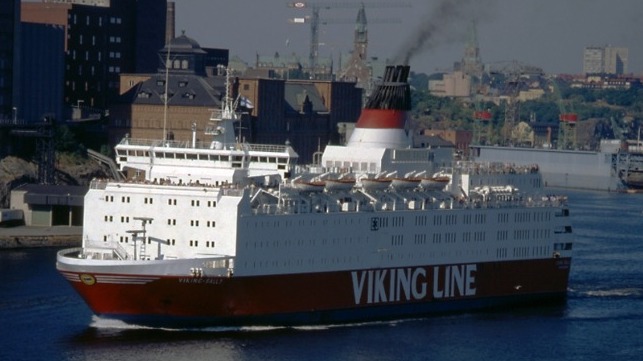Investigators Raise the Bow Ramp of the Long-Lost Ferry Estonia

A joint Estonian, Swedish and Finnish salvage team has raised the bow loading ramp of the ill-fated ro/pax ferry Estonia, which went down nearly 30 years ago in a storm in the Baltic Sea. The tragedy was one of the most deadly maritime casualties in decades, claiming the lives of 852 people, and investigators hope to lay to rest a longstanding debate over the cause of her loss.
Working from the deck of the Eidesvik research vessel Viking Reach, the salvage team used ROVs to explore the wreck site in detail and obtain video footage from multiple angles. After several days of survey work, they used the robotic vehicles to dredge out sediment from around the damaged bow ramp and rig the piece for hoisting. The 12-tonne ramp was brought to the surface and swung onto deck on Tuesday morning.
Ekspertu komanda otrdien no Baltijas j?ras dzelmes izc?lusi 1994.gad? nogrimuš? pr?mja "Estonia" priekšgala rampu, v?sta Igaunijas sabiedrisk? raidorganiz?cija ERR. Rampa ar izp?tes ku?i "Viking Reach" tiks nog?d?ta Paldisku Dienvidu ost? Igaunij?. pic.twitter.com/YsIE2mAhE7
— LTV Zi?u dienests (@ltvzinas) July 25, 2023
The ramp is a key piece of evidence for the investigation. The sinking was initially blamed on the failure of the ship's bow shield, the hinged visor that protected the ramp and gave access to the wide ro/ro decks on the interior. The ship's designer had used the load calculations for typical non-opening bows for its construction, and called for mild steel construction throughout - even for the attachment mechanisms, which were subject to high loads. During the initial site dives in the 1990s, the bow visor was found torn off the ship at a distance from the rest of the wreck; it was recovered and photographed shortly after the accident, but it was scrapped and is no longer available to investigators.
In the years after the sinking, the accident was shrouded in official secrecy: authorities forbade any dive visits to the wreck site and even made plans to cover it in concrete. Victims' families and independent researchers have long maintained that something else might have been to blame, like an explosion or a collision with a submarine.
In a past independent report by news outlet Fokus Estonia, demolition experts suggested that photographs of the (now-scrapped) bow visor showed complex tearing and folding patterns that would only be consistent with explosion damage. Private ROV explorations in 2020 also revealed that the wreck had large openings in its hull, perhaps indicative of damage sustained before the sinking.
A joint Estonian, Finnish and Swedish report released earlier this year pushed back on these controversial claims and endorsed the original conclusion - bow visor failure. The recovery of the ramp will contribute to this debate, as it figures prominently in the official sequence of events: government investigators believe that the flailing bow visor crushed a compartment down onto the top of the ramp, causing the ramp's failure and the subsequent flooding.
The recovered ramp will be brought back to shore, and the authorities intend to undertake a thorough investigation including metal analysis, laser scanning, and chemical analysis. Their hope is that the results will affirm the finding that the disaster was the result of design and construction flaws, not a collision or explosion.
"Naturally, this is a very difficult moment emotionally, because it was certainly a major disaster and a very difficult moment for many people, but I hope that our investigation will provide answers and finally obtain some closure on this matter," chief of the Estonian Safety Investigation Bureau Märt Ots told outlet ERR.
Investigators have also obtained sediment samples from the seabed in the area near the tear in Estonia's hull, which may help confirm their belief that this element of the damage occurred when the wrecked vessel struck the bottom.
